
The telephone-pole beetle is a beetle native to the eastern United States, and the only living representative of the otherwise extinct family Micromalthidae. They have an unusual lifecycle involving asexually reproducing (parthenogenetic) female larvae, as well as non-functional "ghost adults".

Darkling beetle is the common name for members of the beetle family Tenebrionidae. The number of species in the Tenebrionidae is estimated at more than 20,000 and the family is cosmopolitan in distribution.

Hydrophilidae, also known colloquially as water scavenger beetles, is a family of beetles. Aquatic hydrophilids are notable for their long maxillary palps, which are longer than their antennae. Several of the former subfamilies of Hydrophilidae have recently been removed and elevated to family rank; Epimetopidae, Georissidae, Helophoridae, Hydrochidae, and Spercheidae. While the majority of hydrophilids are aquatic, around a third of described species are terrestrial, mostly belonging to the subfamily Sphaeridiinae.

Derodontidae is a family of beetles, in its own superfamily, Derodontoidea, sometimes known as the tooth-necked fungus beetles. Beetles of this family are small, between 2 and 6 mm in length, typically with spiny margins on their pronotum that give them their name, though the genus Laricobius lacks these spines. Unusual among beetles, they have two ocelli on the top of their heads.
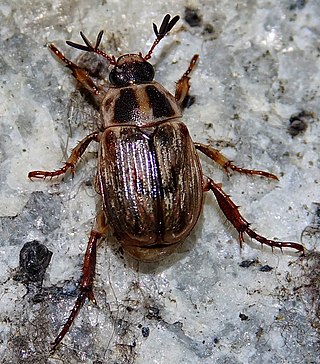
The Oriental beetle is a species of shining leaf chafer in the family Scarabaeidae. It is a beetle about 0.7 - 1.1 cm long, with mottled, metallic brown- and black-colored elytra and a similarly colored thorax and head during the adult stage. It is sometimes confused with the larger and more colorful Japanese beetle. During the larval stage, the Oriental beetle can be identified by the parallel line raster pattern.
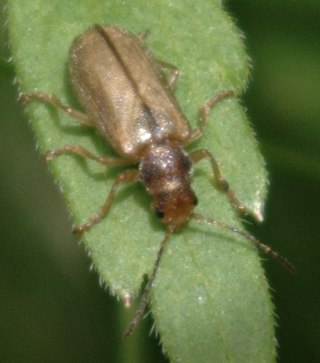
The Synetinae are a small subfamily within the leaf beetle family (Chrysomelidae). They are found entirely within the Holarctic, mainly in North America but also appearing in parts of Europe and Asia. The subfamily contains only two genera, Syneta and Thricolema, with a total of 12 described species. The group is sometimes treated as a tribe of Eumolpinae, where they are known as Synetini.

Melolonthinae is a subfamily of the scarab beetles. It is a very diverse group; distributed over most of the world, it contains over 11,000 species in over 750 genera. Some authors include the scarab subfamilies Euchirinae and Pachypodinae as tribes in the Melolonthinae.
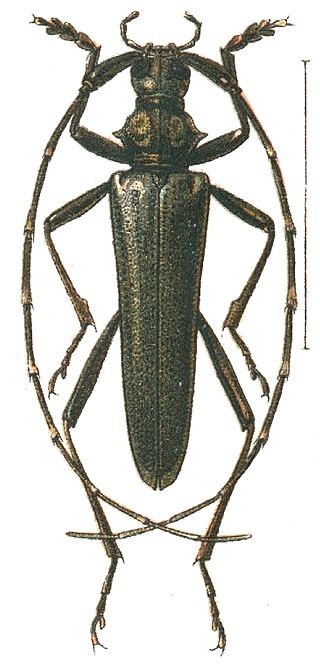
The Disteniidae are a small family of beetles in the superfamily Chrysomeloidea, traditionally treated as a group within the Cerambycidae.
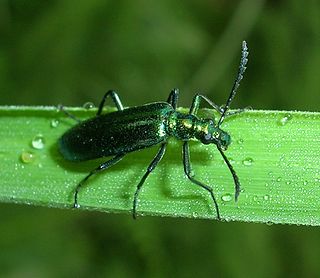
Prionoceridae is a small family of beetles, in the suborder Polyphaga. They form a group within the cleroid beetles and were formerly treated as a subfamily (Prionocerinae) within the family Melyridae. Very little is known of their life history but most species are pollen feeders as adults and occur in large numbers during spring or the host flowering season. Larvae are predatory or feed on decomposing wood.
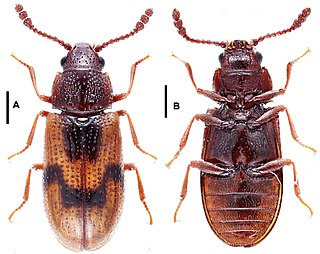
Lamingtonium is the only genus in the family Lamingtoniidae, of the beetle superfamily Cucujoidea. It contains three species endemic to Australia. The holotype of the type species was collected on at Lamington National Park, Binna Burra, Queensland under the bark of a dead tree. The adults and larvae of two species have been found associated with basidiocarps of fungi belonging to the family Polyporaceae.

The Brachypsectridae are a family of beetles commonly known as the Texas beetles. There are only two extant genera, Brachypsectra and Asiopsectra. Brachypsectra has a cosmopolitan distribution, mostly in arid regions, while Asiopsectra is found in Central Asia and the Middle East.
Syneta albida, the western fruit beetle, is a species of beetles from the family of leaf beetles, subfamily Synetinae.

Syneta is a genus of leaf beetles in the subfamily Synetinae. There are about 11 described species in Syneta. The genus is entirely holarctic in distribution, with species appearing in North America, Siberia, East Asia and Northern Europe.

Ancyronyx, commonly known as spider water beetles or spider riffle beetles, is a genus of aquatic riffle beetles from North America, South Asia, China, and Southeast Asia. They are small beetles with extremely long legs ending in strong claws. Both the adults and the larvae are found underwater in the shallow riffles of streams and rivers, clinging to rocks or submerged wood. They feed on algae and decaying wood tissue. The genus contains twenty-one species, eleven of which are endemic to the Philippines.
Syneta extorris is a species of leaf beetle. It is found in eastern North America.
Syneta hamata is a species of leaf beetle. It is found in western North America.
Syneta simplex is a species of leaf beetle found in North America. The species includes the two subspecies Syneta simplex simplex, which lives at elevations considerably below timberline and feeds on Garry oak, and Syneta simplex subalpina, which is found near timberline in Washington and British Columbia and feeds on alpine fir.
Syneta seriata is a species of leaf beetle. It is found in North America. It feeds on California live oak and California black oak.
Isodacrys is a genus of broad-nosed weevils in the beetle family Curculionidae. There are 20 described species in Isodacrys, ranging from the southern United States of America to Honduras.

Aspidytidae is a family of aquatic beetles of the suborder Adephaga, described in 2002 from specimens in South Africa and China. There are only two known species in the family and these were originally described in the genus Aspidytes, but later the new genus Sinaspidytes was erected for the species found in China. The family can also be referred to by its trivial name cliff water beetles.












